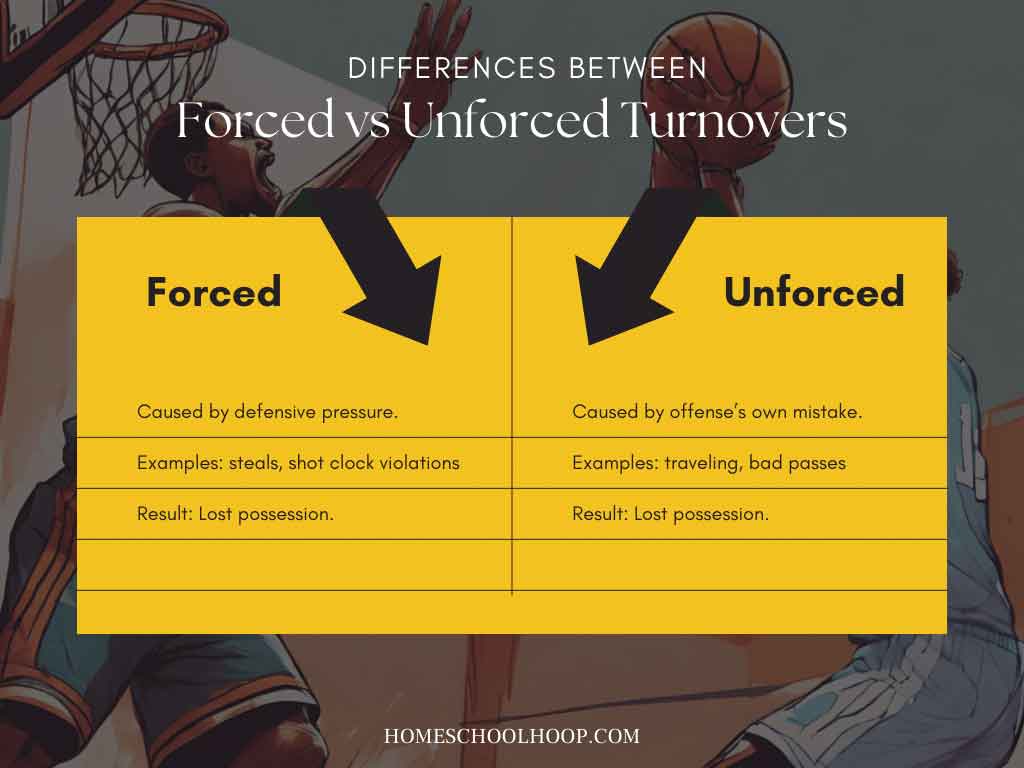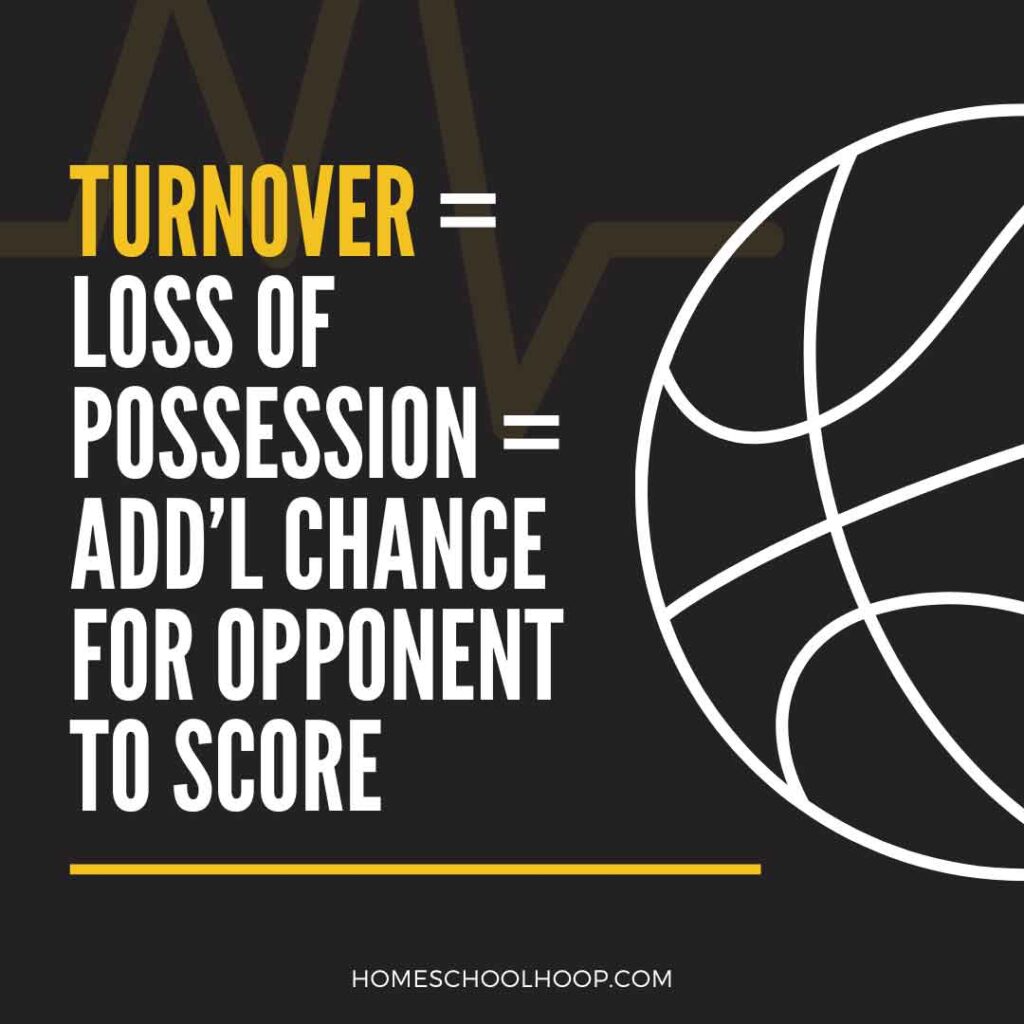If you were to poll basketball coaches about the one key to winning, a huge majority would answer: limit turnovers. And they wouldn’t be exaggerating. A turnover in basketball can be the deciding factor between winning and losing.
Key Takeaways:
- A turnover in basketball means losing possession of the ball to the other team, either due to a mistake or their defense.
- The main reasons for turnovers are traveling, bad passes, and offensive fouls.
- Every turnover means a missed chance to score and an additional chance for the other team to score.
So, let’s dive into the question – What is a turnover in basketball? Here, we’ll look at turnovers, what causes them, how they affect the game, and how to prevent them.
What is a Turnover in Basketball?
A turnover in basketball happens when one team unintentionally gives the ball to the opposing team without attempting a field goal or a free throw. This can occur in several ways, but the result is the same: the team with the ball loses it, and the other team gets a chance to attack and possibly score.
Turnovers have a big impact on basketball games. They result in:
- A shift in momentum: Losing the ball boosts the other team’s confidence (and crushes the confidence of the team that turned the ball over).
- Lost scoring opportunities: Every turnover is a missed chance to score points.
- Potential opponent scoring: The other team might get a fast break and score quickly after a turnover.

Every turnover in basketball plays a critical role in shaping the outcome of a game. Teams with high turnover rates struggle because they are giving up scoring opportunities. It’s hard to give the ball away so many times and not get outscored.
Types of Turnovers
There is more than one way to turn the ball over, but each one can disrupt the flow of the game and influence who pulls out the win.
Forced vs. Unforced Turnovers
Turnovers are categorized into two main types: forced and unforced.

Forced turnovers occur when the opposing team’s actions directly cause the turnover. Examples include:
- Steals: A defender strips the ball-handler and gains possession, or a defender intercepts a pass.
- Shot clock violations: The defense applies so much pressure that the offense is unable to get off a shot before the shot clock runs out.
Unforced turnovers happen because of a team’s own mistakes, without direct pressure from opponents. Examples include:
- Traveling: Taking too many steps without dribbling results in traveling in basketball.
- Bad passes: An offensive player throws the ball out of bounds or to an area where a teammate can’t reach it.
Common Causes of Turnovers
So, what counts as a turnover in basketball? Here are some of the most common ways teams turn the ball over to the other team:
- Bad passes: Inaccurate or ill-timed passes that are intercepted or go out-of-bounds. A 2011 study found passing errors accounted for 40.2% of turnovers in women’s National League basketball games.
- Traveling violations: Moving with the ball without maintaining a continuous dribble.
- Double dribbling: Starting to dribble again after stopping the dribble without passing or shooting the ball is a double dribble violation.
- Carry violation: Illegally resting the hand under the ball while dribbling is a carry in basketball.
- Offensive fouls: Illegal contact made by an offensive player, like a charge in basketball or a moving screen.
- Shot clock violations: Failing to attempt a shot and hitting the rim within the time allotted by the shot clock.
- 5-second rule violations: Not passing the ball from out-of-bounds within the 5-second rule limit.
- Backcourt violations: Failing to bring the ball over the mid-court line within the 8 or 10 second limit is one type of common backcourt violation.
TRIVIA:
Who holds the record for the most turnovers in an NBA Playoff game?
Clue 1: This player set the NBA playoff game record for turnovers with 13 in a single game.
Clue 2: The record was set on May 27, 2015, during a Western Conference Finals game.
Clue 3: At the time, he was playing for the Houston Rockets against the Golden State Warriors.
Scroll to the bottom for the answer.
The Impact of Turnovers on Game Outcomes
Turnovers in basketball are not the only factor that determines whether a team wins or loses. However, minimizing turnovers is a crucial piece of a winning strategy. This is because teams with a lower turnover rate typically are more efficient on the offensive end of the floor and thus more likely to win.
Research has found that winning teams have fewer turnovers (among other statistical advantages like more defensive rebounds and assists).
This is not at all surprising, since each turnover represents a missed chance to put the ball in the basket. Turnovers often lead to fast-break chances for the other team. This disrupts the setup of the team that lost the ball and is scrambling back on defense thus giving them easier scoring chances.

Additionally, a turnover also quickly changes the game’s pace, shifting momentum to the opposing team. This psychological impact can energize the team gaining possession and demoralizing the team losing it.
Over the course of a game, these lost opportunities can add up, affecting the final score.
Notable Turnovers in Basketball History
Turnovers are often at the heart of the most exciting basketball moments. Let’s explore some of the most famous (or my favorite) turnovers in basketball history:
#1 Draymond Green’s Costly Turnover in 2016 NBA Playoffs
With one second to go in Game 3 of the 2016 NBA Western Conference First Round playoff series, Draymond Green of the Golden State Warriors turns his head a moment too early and fumbles an inbounds pass out-of-bounds. This clinched the game for the Houston Rockets.
#2 Courtney Vandersloot Gets Intercepted To Give Up 2019 Playoff Win
With less than 10 seconds left in a 2019 WNBA Playoff Semifinals elimination game, the Chicago Sky throw an errant pass for a turnover, Dearica Hamby of the Las Vegas Aces intercepts it and heaves in a long-range three to win the game.
#3 Drake’s Turnover Leads to Caitlyn Clark’s Dominating Sequence
In the fourth quarter of a game already in hand between Iowa and Drake, Caitlyn Clark forces Drake to turn the ball over and hits two logo threes in 45 seconds.
Are you a Caitlin Clark fan? See our list of best Caitlin Clark quotes.
Preventing Turnovers: Tips and Strategies
Turnovers are going to happen, but minimizing them through sound fundamentals and good decision-making will make winning more likely. Putting players through both basketball fundamental drills and game-like scrimmage situations can help.
- Emphasize fundamentals: Players more skilled in dribbling, passing, and catching are less likely to play sloppy and turn the ball over. Cone drills can help improve dribbling skills and passing drills can help with accuracy.
- Practice under pressure: In the turnover examples above, you’ll notice that players turned the ball over because they felt rushed or it was a high-stakes situation. So, simulate game scenarios that require quick decision-making to prepare for this real-game pressure.

FAQs
What is the difference between a steal and a turnover in basketball?
A steal happens when a defender successfully takes the ball away from the offense, leading to a turnover. A turnover is any loss of possession, such as bad passes or violations, not just those caused by steals.
Is getting your shot blocked a turnover?
No. Getting your shot blocked is not considered a turnover. A turnover only occurs when possession changes teams without a shot attempt. Plus, sometimes, a blocked shot often remains in the possession of the shooting team.
Who has the most turnovers in NBA history?
The player who has committed the most turnovers in NBA history is LeBron James. As of February 8, 2024, he has 5,117 career turnovers.
Who has the most turnovers in WNBA history?
The player with the most turnovers in WNBA history is Diana Taurasi. As of February 8, 2024, she has 1,452 career turnovers.
Why are turnovers bad in basketball?
Turnovers are bad because they give the ball to the opposing team, losing a chance to score and potentially allowing the opponents to score. They disrupt a team’s rhythm and can shift momentum to the other team.
SHARE YOUR EXPERIENCE
Today, you learned what a turnover is in basketball.
So we want to know: What’s your favorite or most memorable turnover moment?
Describe the play and why it stands out to you in the comments.
The TRIVIA answer is James Harden.


